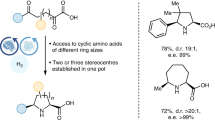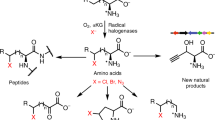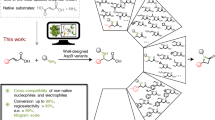Abstract
A concise and highly efficient synthetic route to L-azidohomoalanine (L-Aha) and its homologues is presented here. These chemically modified amino acids are used for the introduction of bioorthogonal handles into proteins. The described route avoids major problems of previously reported methods including expensive starting materials, low efficiency, and lack of scalability. Starting from inexpensive N-Boc-O-Bn-L-aspartic acid, gram quantities of L-Aha hydrochloride can be prepared with high purity. The reactions can be completed within 1 week and the products can be incorporated into proteins using L-methionine auxotrophs.
This is a preview of subscription content, access via your institution
Access options
Subscribe to this journal
Receive 12 print issues and online access
$259.00 per year
only $21.58 per issue
Buy this article
- Purchase on Springer Link
- Instant access to full article PDF
Prices may be subject to local taxes which are calculated during checkout

Similar content being viewed by others
References
Sletten, E.M. & Bertozzi, C.R. Bioorthogonal chemistry: fishing for selectivity in a sea of functionality. Angew. Chem. Int. Ed. 48, 6974–6998 (2009).
Van Hest, J.C.M., Kiick, K.L. & Tirrell, D.A. Efficient incorporation of unsaturated methionine analogues into proteins in vivo. J. Am. Chem. Soc. 122, 1282–1288 (2000).
Datta, D., Wang, P., Carrico, I.S., Mayo, S.L. & Tirrell, D.A. A designed phenylalanyl-tRNA synthetase variant allows efficient in vivo incorporation of aryl ketone functionality into proteins. J. Am. Chem. Soc. 124, 5652–5653 (2002).
Kiick, K.L., Saxon, E., Tirrell, D.A. & Bertozzi, C.R. Incorporation of azides into recombinant proteins for chemoselective modification by the Staudinger ligation. Proc. Natl Acad. Sci. USA 99, 19–24 (2002).
Link, A.J. & Tirrell, D.A. Cell surface labeling of Escherichia coli via copper(I)-catalyzed [3+2] cycloaddition. J. Am. Chem. Soc. 125, 11164–11165 (2003).
Agard, N.J., Baskin, J.M., Prescher, J.A., Lo, A. & Bertozzi, C.R. A comparative study of bioorthogonal reactions with azides. ACS Chem. Biol. 1, 644–648 (2006).
Rostovtsev, V.V., Green, L.G., Fokin, V.V. & Sharpless, K.B. A stepwise Huisgen cycloaddition process: copper(I)-catalyzed regioselective “ligation” of azides and terminal alkynes. Angew. Chem. Int. Ed. 41, 2596–2599 (2002).
Kolb, H.C., Finn, M.G. & Sharpless, K.B. Click chemistry: diverse chemical function from a few good reactions. Angew. Chem. Int. Ed. 40, 2004–2021 (2001).
Meldal, M. & Tornoe, C.W. Cu-catalyzed azide-alkyne cycloaddition. Chem. Rev. 108, 2952–3015 (2008).
Codelli, J.A., Baskin, J.M., Agard, N.J. & Bertozzi, C.R. Second-generation difluorinated cyclooctynes for copper-free click chemistry. J. Am. Chem. Soc. 130, 11486–11493 (2008).
Baskin, J.M. et al. Copper-free click chemistry for dynamic in vivo imaging. Proc. Natl. Acad. Sci. USA 104, 16793–16797 (2007).
Sletten, E.M. & Bertozzi, C.R. A hydrophilic azacyclooctyne for Cu-free click chemistry. Org. Lett. 10, 3097–3099 (2008).
Chang, P.V. et al. Copper-free click chemistry in living animals. Pro. Natl. Acad. Sci. USA 107, 1821–1826 (2010).
Oh, K.-I., Lee, J.-H., Joo, C., Han, H. & Cho, M. β-Azidoalanine as an IR probe: application to amyloid Aβ(16-22) aggregation. J. Phys. Chem. B 112, 10352–10357 (2008).
Ye, S., Huber, T., Vogel, R. & Sakmar, T.P. FTIR analysis of GPCR activation using azido probes. Nat. Chem. Biol. 5, 397–399 (2009).
Griffin, R.J. The medicinal chemistry of the azido group. Prog. Med. Chem. 31, 121–232 (1994).
Wang, L., Xie, J. & Schultz, P.G. Expanding the genetic code. Ann. Rev. Biophys. Biomol. Struct. 35, 225–249 (2006).
Wiltschi, B., Merkel, L. & Budisa, N. Fine tuning the N-terminal residue excision with methionine analogues. Chembiochem 10, 217–220 (2009).
Link, A.J., Vink, M.K.S. & Tirrell, D.A. Presentation and detection of azide functionality in bacterial cell surface proteins. J. Am. Chem. Soc. 126, 10598–10602 (2004).
Link, A.J., Vink, M.K.S. & Tirrell, D.A. Preparation of the functionalizable methionine surrogate azidohomoalanine via copper-catalyzed diazotransfer. Nat. Protoc. 2, 1879–1883 (2007).
Link, A.J., Vink, M.K.S. & Tirrell, D.A. Synthesis of the functionalizable methionine surrogate azidohomoalanine using Boc-homoserine as precursor. Nat. Protoc. 2, 1884–1887 (2007).
Mangold, J.B., Mischke, M.R. & LaVelle, J.M. Azidoalanine mutagenicity in Salmonella: effect of homologation and a-methyl substitution. Mut. Res. 216, 27–33 (1989).
LaVelle, J.M. & Mangold, J.B. Structure–activity relationships of the azide metabolite, azidoalanine, in S. typhimurium. Mutat. Res. 177, 27–33 (1987).
Mangold, J.B., Yaohony, D., Mischke, M.R. & LaVelle, J.M. Effects of deuterium labeling on azido amino acid mutagenicity in Salmonella typhimurium. Mutat. Res. 308, 33–42 (1994).
Roth, S. & Thomas, N.R. A concise route to L-azidoamino acids: L-azidoalanine, L-azidohomoalanine and L-azidonorvaline. Synlett 4, 607–609 (2010).
Keicher, T. & Löbbecke, S. in Organic Azides: Syntheses and Applications (eds., Bräse, S. & Banert, K.) 3–27 (John Wiley & Sons, 2010).
Acknowledgements
We thank the Biotechnology and Biosciences Research Council (BBSRC) (BBE0140891) and Medical Research Council (MRC) (G0801741) for funding this project. The thermogravimetric analysis and dynamic scanning calorimetry measurements on L-Aha were conducted by E. Greenhalgh under the supervision of D. Irvine at the University of Nottingham.
Author information
Authors and Affiliations
Contributions
S.R. conducted the initial syntheses and determined the synthetic routes as well as prepared the first draft of the manuscript. W.C.D. repeated and refined the syntheses; he also modified the reaction conditions and reagents for several steps to improve yields when conducting the reactions on a larger scale. He was also involved in manuscript preparation. N.R.T. supervised all of the work and prepared the final version of the manuscript.
Corresponding author
Ethics declarations
Competing interests
The authors declare no competing financial interests.
Supplementary information
Supplementary Data 1
1H NMR spectrum of L-Aha·HCl. (PDF 21 kb)
Supplementary Data 2
13C NMR spectrum of L-Aha·HCl. (PDF 34 kb)
Rights and permissions
About this article
Cite this article
Roth, S., Drewe, W. & Thomas, N. A concise and scalable route to L-azidohomoalanine. Nat Protoc 5, 1967–1973 (2010). https://doi.org/10.1038/nprot.2010.164
Published:
Issue Date:
DOI: https://doi.org/10.1038/nprot.2010.164
This article is cited by
-
Nonradioactive quantification of autophagic protein degradation with L-azidohomoalanine labeling
Nature Protocols (2017)
Comments
By submitting a comment you agree to abide by our Terms and Community Guidelines. If you find something abusive or that does not comply with our terms or guidelines please flag it as inappropriate.



